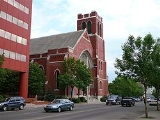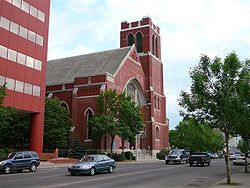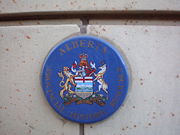
Heritage buildings in Edmonton
Encyclopedia
Heritage buildings in Edmonton, as elsewhere in Canada
, may be designated by any of the three levels of government: the Government of Canada
(federal government), the Government of Alberta (provincial government), or the City of Edmonton (municipal government).
and listed in the Directory of Designations of National Historic Significance of Canada, and one recommendation to create a new plaque in Edmonton. Only National Historic Sites commemorate buildings, and there is only one National Historic Site in Edmonton, the former location of Fort Edmonton
near the Alberta Legislature Building. There are also four plaques for National Historic People and National Historic Events in the city.
The federal government also has a separate heritage register for buildings it owns, under the Federal Heritage Buildings program. In Edmonoton, three buildings are listed: the Grierson Centre
's, former RCMP Centre Building 3 (now a prison), and two buildings at CFB Edmonton
, the Headquarters Army Western Command Building J3 at Edmonton Garrison, and the Spall Block, Building h-14 at Griesbach
.
The only other heritage recognition provided to buildings by the federal government is that of "Heritage Railway Station" (because railways are federally regulated). The former Strathcona Canadian Pacific Railway Station
is one such station.

 Historic designation in Alberta is governed by the Historic Resources Act. Sites owned and run by the provincial government as a functioning historic site or museum are known as Provincial Historic Sites. The two Provincial Historic Sites in Edmonton are the Royal Alberta Museum
Historic designation in Alberta is governed by the Historic Resources Act. Sites owned and run by the provincial government as a functioning historic site or museum are known as Provincial Historic Sites. The two Provincial Historic Sites in Edmonton are the Royal Alberta Museum
, and Rutherford House
. Buildings and sites owned by private citizens and companies or other levels or branches of government may gain one of two levels of historic designation: "Registered Historic Resource" or "Provincial Historic Resource" (the later being the higher designation). There are 45 Provincial Historic Resources and 30 Registered Historic Resources listed with the Alberta Register of Historic Places within Edmonton city boundaries. Since 2007 the provincial government has also recognized the Old Strathcona
district as a "Provincial Historic Area", only the second such area in Alberta.
The province also lists buildings deemed historically significant by municipal governments on the Alberta Register of Historic Places, which is also part of the larger Canadian Register of Historic Places
although this does not imply provincial or federal government status or protection.
. However the owner must be notified and city council must vote to approve designating a building as a Municipal Historic Resources. Only Municipal Historic Resources are protected from demolition
. In addition to this the City publishes a list of historic resources that were demolished after being added to the register. In the last report 27 historic buildings were listed as demolished. As an appendix to the Register, the City also lists all buildings at the municipal Fort Edmonton Park
museum, and historically significant landscapes, cemeteries and monuments, street furnishings, and architectural fragments.
Canada
Canada is a North American country consisting of ten provinces and three territories. Located in the northern part of the continent, it extends from the Atlantic Ocean in the east to the Pacific Ocean in the west, and northward into the Arctic Ocean...
, may be designated by any of the three levels of government: the Government of Canada
Government of Canada
The Government of Canada, formally Her Majesty's Government, is the system whereby the federation of Canada is administered by a common authority; in Canadian English, the term can mean either the collective set of institutions or specifically the Queen-in-Council...
(federal government), the Government of Alberta (provincial government), or the City of Edmonton (municipal government).
Federal sites
there are currently ten sites in Edmonton with plaques erected by Parks CanadaParks Canada
Parks Canada , also known as the Parks Canada Agency , is an agency of the Government of Canada mandated to protect and present nationally significant natural and cultural heritage, and foster public understanding, appreciation, and enjoyment in ways that ensure their ecological and commemorative...
and listed in the Directory of Designations of National Historic Significance of Canada, and one recommendation to create a new plaque in Edmonton. Only National Historic Sites commemorate buildings, and there is only one National Historic Site in Edmonton, the former location of Fort Edmonton
Fort Edmonton
Fort Edmonton was the name of a series of trading posts of the Hudson's Bay Company from 1795 to 1891, all of which were located in central Alberta, Canada...
near the Alberta Legislature Building. There are also four plaques for National Historic People and National Historic Events in the city.
The federal government also has a separate heritage register for buildings it owns, under the Federal Heritage Buildings program. In Edmonoton, three buildings are listed: the Grierson Centre
Grierson Centre
The Grierson Centre is a minimum security institution in Downtown Edmonton. It is run and operated by Correctional Service of Canada.The site of the Grierson Centre was originally the North West Mounted Police's headquarters in Edmonton. One of the buildings in the Grierson Centre, former RCMP...
's, former RCMP Centre Building 3 (now a prison), and two buildings at CFB Edmonton
CFB Edmonton
CFB Edmonton is a Canadian Forces base located in Edmonton, Alberta, Canada. It is also known as Edmonton Garrison or "Steele Barracks".-History:...
, the Headquarters Army Western Command Building J3 at Edmonton Garrison, and the Spall Block, Building h-14 at Griesbach
Griesbach, Edmonton
Griesbach is a residential neighbourhood in the Castledowns area of north west Edmonton, Alberta, Canada. This neighbourhood was formerly a military base, part of CFB Edmonton...
.
The only other heritage recognition provided to buildings by the federal government is that of "Heritage Railway Station" (because railways are federally regulated). The former Strathcona Canadian Pacific Railway Station
Strathcona Canadian Pacific Railway Station
The Strathcona Canadian Pacific Railway Station was built by the Calgary and Edmonton Railway in what was then the City of Strathcona, Alberta. It was started in 1907, completed in 1908, and expanded in 1910, and is located at what is now 8101 Gateway Boulevard, just south of Whyte Avenue.The...
is one such station.
Provincial sites


Royal Alberta Museum
The Royal Alberta Museum is located in Edmonton, Alberta and was named the Provincial Museum of Alberta until 24 May 2005 when Queen Elizabeth II visited, bestowing royal patronage. It has a natural history exhibit, a wildlife exhibit, an entomology exhibit, a Native Culture exhibit, as well as...
, and Rutherford House
Rutherford House
Rutherford House was the home of the first Premier of Alberta, Alexander Cameron Rutherford from 1911 to 1941. It is now an Alberta Provincial Historic Site.-Overview:...
. Buildings and sites owned by private citizens and companies or other levels or branches of government may gain one of two levels of historic designation: "Registered Historic Resource" or "Provincial Historic Resource" (the later being the higher designation). There are 45 Provincial Historic Resources and 30 Registered Historic Resources listed with the Alberta Register of Historic Places within Edmonton city boundaries. Since 2007 the provincial government has also recognized the Old Strathcona
Old Strathcona
Old Strathcona is an historic district located in south-central Edmonton, Alberta, Canada. Once the commercial core of the separate city of Strathcona, the area is now Edmonton's main arts and entertainment district, and in 2007 was named Alberta's second "Provincial Historic Area"...
district as a "Provincial Historic Area", only the second such area in Alberta.
The province also lists buildings deemed historically significant by municipal governments on the Alberta Register of Historic Places, which is also part of the larger Canadian Register of Historic Places
Canadian Register of Historic Places
The Canadian Register of Historic Places is an online, searchable database that includes listings of historic places important to communities, cities, provinces, territories, and the nation...
although this does not imply provincial or federal government status or protection.
Municipal sites
The City of Edmonton maintains the "Register of Historic Resources in Edmonton" which has several different categories of buildings and sites: Municipal Historic Resources (76 sites), A-List Resources (190 sites), and B-List Resources (305 sites), for a total of 571 sites on the register. Sites can be put on the Register, which is simply a list of buildings the city deems "historic," by the City's staff at any time without the knowledge of the owner or city councilCity council
A city council or town council is the legislative body that governs a city, town, municipality or local government area.-Australia & NZ:Because of the differences in legislation between the States, the exact definition of a City Council varies...
. However the owner must be notified and city council must vote to approve designating a building as a Municipal Historic Resources. Only Municipal Historic Resources are protected from demolition
Demolition
Demolition is the tearing-down of buildings and other structures, the opposite of construction. Demolition contrasts with deconstruction, which involves taking a building apart while carefully preserving valuable elements for re-use....
. In addition to this the City publishes a list of historic resources that were demolished after being added to the register. In the last report 27 historic buildings were listed as demolished. As an appendix to the Register, the City also lists all buildings at the municipal Fort Edmonton Park
Fort Edmonton Park
Fort Edmonton Park is an attraction in Edmonton, Alberta, Canada. Named for the first enduring European post in the area of modern-day Edmonton, the park is the largest living history museum in Canada by area...
museum, and historically significant landscapes, cemeteries and monuments, street furnishings, and architectural fragments.

